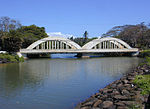Mokulēia, Hawaii
Census-designated places in Honolulu County, HawaiiPages with Hawaiian IPAPopulated coastal places in HawaiiPopulated places on Oahu

Mokulēʻia (Hawaiian pronunciation: [mokuleːˈʔijə]) is a North Shore community and census-designated place (CDP) in the Waialua District on the island of Oʻahu, City & County of Honolulu, Hawaiʻi, United States. Mokulēʻia means "isle [of] abundance" in Hawaiian. As of the 2020 census, the CDP had a population of 1,816. Features of interest here include Mokulēʻia Beach, Mokulēʻia Polo Field, and Dillingham Airfield, west of the town. At the western end of Farrington Highway, approximately 1-mile (1.6 km) beyond Dillingham Airfield entrance, begins the track (trail) to Kaʻena Point, the westernmost tip of Oʻahu. The U.S. postal code for Mokulēʻia is 96791.
Excerpt from the Wikipedia article Mokulēia, Hawaii (License: CC BY-SA 3.0, Authors, Images).Mokulēia, Hawaii
Mahinaai Street,
Geographical coordinates (GPS) Address Nearby Places Show on map
Geographical coordinates (GPS)
| Latitude | Longitude |
|---|---|
| N 21.577222222222 ° | E -158.15888888889 ° |
Address
Mahinaai Street
Mahinaai Street
96791
Hawaii, United States
Open on Google Maps







